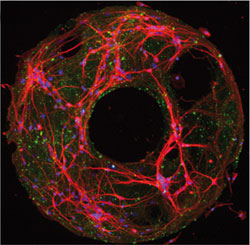
The ring structure of the neuron networks was prepared by stamping proteins onto a glass substrate and growing neurons on the proteins
US scientists have created a model of the ring-shaped networks of neurons in the brain, which could help researchers to understand small changes within diseased brain cells.
Henry Zeringue, and colleagues at the University of Pittsburgh, developed the model to enable the study of brain circuitry in an in vitro system instead of using brain slices. In neurological diseases, such as Alzheimer’s disease, subtle changes in this activity take years, or even decades, to become clinically detectable. Most studies only explore the electrical properties of a single neuron or the connection between two neurons. Until now, there hasn’t been a good model to study network activity in vitro.
Zeringue and his team are considering using their platform to characterise network-level changes based on small experimental perturbations, like changes in network geometry or expression of mutant proteins in 10 per cent of the neurons. ‘Deciphering the relationship between the connectivity of the neurons and the activity in the ring culture will be challenging and unravelling the connections between the neurons may still prove to be a daunting task,’ he concludes.
Read Carl Saxton’s Chemistry World article online here or go straight to the Lab on a Chip paper:
Ring-shaped neuronal networks: a platform to study persistent activity
Ashwin Vishwanathan, Guo-Qiang Bi and Henry C. Zeringue,
Lab Chip, 2011, 11, 1081
DOI: 10.1039/c0lc00450b










